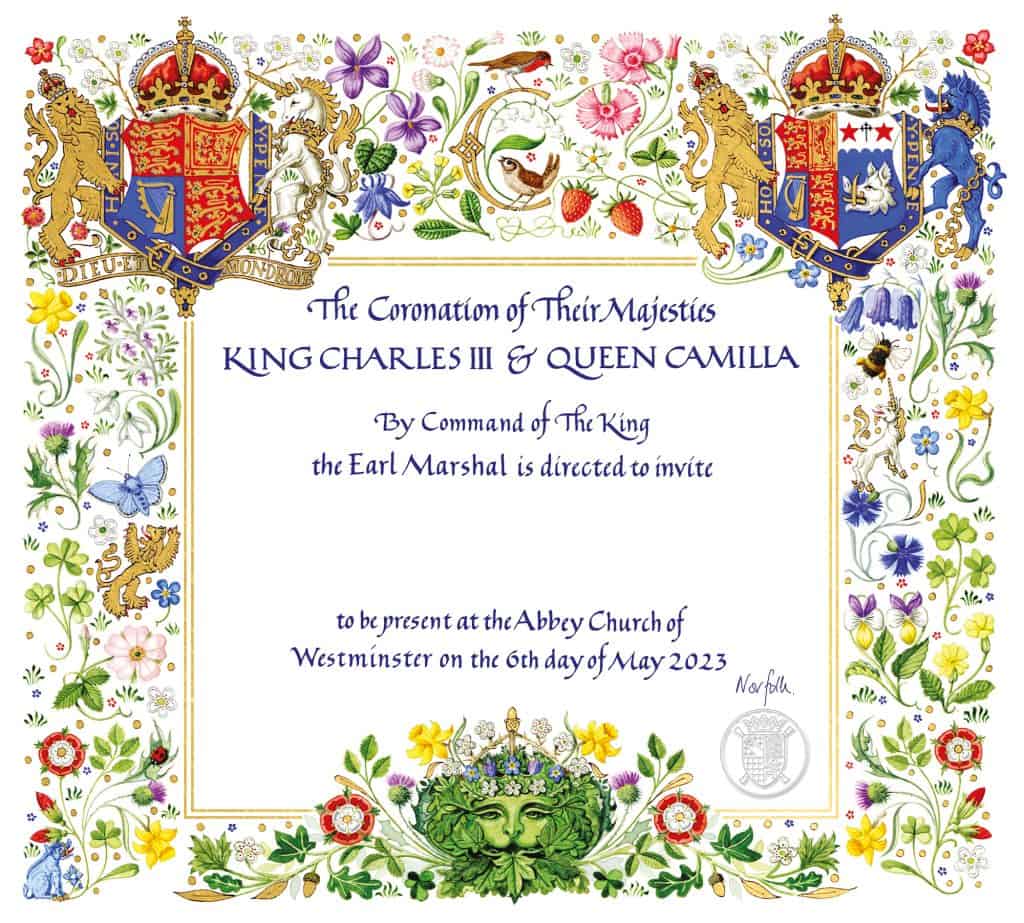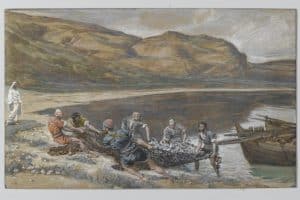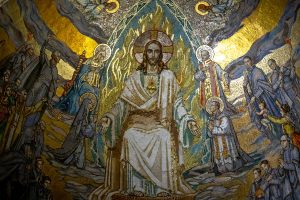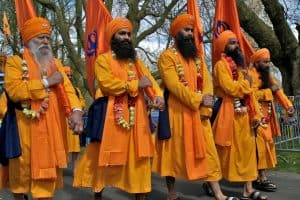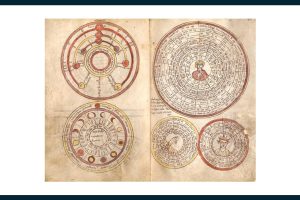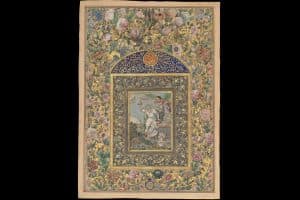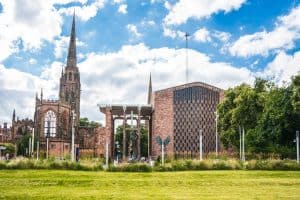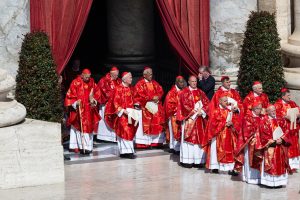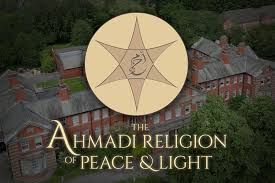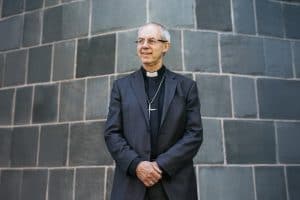By Jennifer Uzzell
Invitations to the coronation of King Charles III, designed by manuscript illustrator Andrew Jamieson, have provoked much excitement in the media. The debate centres on the Green Man in the centre of the design. Who is the Green Man and what does he represent?
What form does the Green Man take?
“Green Man” is a term frequently applied to images of a man’s head, surrounded by leaves, or disgorging leaves and vegetation from its mouth. These figures are also, less emotively, referred to as “foliate heads” and are a common feature of British churches and cathedrals, medieval manuscripts, and stained glass.
There are examples of the motif to be found all over Britain, in Bolton Abbey, in Rochester Cathedral, and in St Magnus Cathedral on Orkney, as well as in many parish churches, beginning in the 11th century after the Norman Conquest and reaching a peak of popularity in the early 16th century, before they saw a decline following the Reformation.
How is the coronation invitation controversial?
The controversy arises because the Green Man image is widely associated in the popular imagination with folklore and Paganism, leading some to question the King’s intentions in making it the central feature of the coronation invitation.
Some people have seen in it a desire to subvert the Christian church and lead the country into a Wicker Man-style Pagan revival. This is, of course, an extreme reaction, but it has led many to question the King’s commitment to his role as defender of the faith, or to see it as a declaration of his commitment to ecology and care for the environment.
From the old wildwood
Is the Green Man an ancient Pagan woodland god, or is he something far more recent and with a different message?
The term Green Man was first used by Lady Raglan (Julia Somerset, née Hamilton) in a 1939 article The Green Man in Church Architecture, published in The Folklore Journal.
In her article, Lady Raglan sought to explain why such figures appeared in so many churches, and, because they had so much in common with each other, she wondered whether they were representations of a particular figure or personality.
She thought this figure to be the Jack in the Green, a traditional figure represented in May Day celebrations around Britain — notably in Hastings — as well as in figures from folklore associated with the wildwood, such as Robin Hood. These, she believed, were survivals in the popular imagination of a pre-Christian deity of fertility and the forest who had been remembered and celebrated in medieval church architecture.
A 19th-century invention
It is important to remember that at the time Lady Raglan was writing, and indeed since the late 19th century, there had been a renewed interest in folklore, with many contemporary scholars theorising that in it could be traced the survival of ideas, beliefs and customs that pre-dated the arrival of Christianity in the British Isles.
One scholar, Margaret Murray (1863-1963), theorised that the witch trials of the Reformation era were evidence of an ancient goddess-based religion that had survived, hidden in plain sight, throughout the Christian centuries. Many of her ideas were adopted by Gerald Gardner (1884-1964), known as the father of modern Wicca, and survive within the mythology of that religion. Modern scholars reject such theories, pointing out that customs such as morris dancing and the Jack in the Green are comparatively recent, and certainly do not pre-date the coming of Christianity.
A caution against the Devil
There certainly are foliate heads that are genuinely ancient. In A Little Book of the Green Man (1998), the singer and broadcaster Mike Harding gives examples of similar figures from Borneo, Nepal, India and Iraq, dating from the second century BC. There are also many examples from Greece and Rome, representing spirits of the woodland, or particular gods such as Pan or Dionysus.
However, while some of these figures can be found in Roman Britain, once the Romans had departed there is no evidence of anything similar again until they start to appear in church architecture after the Norman Conquest. Medieval stonemasons certainly had fun depicting gargoyles, demons, and sexually explicit female figures known as sheela na gigs and so it is possible to read them, as well as the Green Man, as a caution against becoming involved in “the old ways”, which they would have seen as demon worship.
The fact that they do not appear until well into the Christian period, however, suggests a different reading. Many are clearly warnings against being led astray by the Devil and of the horrors of hell awaiting sinners. Most churchgoers at this time would have been illiterate and so the church itself, its carvings, paintings and stained glass, served as a sermon in their own right. Lady Raglan is, I think, correct in her assumption that the Green Man would be instantly recognisable, and that his message would be immediately familiar to those who saw it. But that does not mean that he must be a survival of an ancient god.
Adam and the tree in Eden
Stephen Miller’s book, The Green Man in Medieval England (2022), takes as its starting point the existence of Christian mythology surrounding the figure of Adam, the first human being to die, and the one (with his wife, Eve) for bringing death and suffering into the world by eating fruit from the tree of the knowledge of good and evil against God’s express commandment.
According to a medieval story, when Adam died, his son Seth buried him and placed a seed from the tree into his mouth. It sprouted into a tree, from which the wood of the cross, the mechanism of redemption and salvation, was taken. Thus Adam, the means of the downfall and damnation of humanity, contained within himself the seed of redemption and foretold the coming of Christ.
The idea of Christ as a second Adam appears in the New Testament and probably forms the origin of this legend. Thus, the figure of a man with leaves bursting forth from his mouth would have been understood by medieval churchgoers as a triumphant symbol of resurrection, redemption and the triumph of Christ. It is not, then, an inappropriate symbol to be chosen by the head of the Church of England for the coronation invitations, but one proudly declaring the victory of Christ over sin and death.

New god for an old religion
The story is not quite so straightforward, however. As we have seen, from the late 19th century there has been an explosion of interest in folklore and seasonal customs, along with a popular belief that these represent a survival of ancient Pagan rites and beliefs. This has influenced the rise of a new Paganism which is rapidly spreading and becoming normalised in modern Britain. In the 2021 Census, 74,000 people identified as Pagan and 13,000 as Wicca.
The fact that it seems unlikely that traditional practices such as the Maypole, the ’Obby ’Oss or the Jack-in-the-Green represent genuinely pre-Christian traditions does not diminish that they have become important in modern Paganism. This is not to suggest that everyone who takes part in these celebrations is a Pagan. Far from it. But many are, and they have been absorbed into contemporary Pagan practice and world views.
The Green Man is no exception. It is almost certain that he has no past as an ancient fertility god — but he has a future as one. The figure of the Green Man has been adopted into modern Pagan thinking as a god who represents the wild, and the vital relationship with nature that we have lost, and that we need to regain to live fully.
He has come to symbolise the ecological movement, especially within Paganism, and the need to reconnect with the wild within ourselves. Examples of Green Man symbolism abound within modern Paganism. In his song The Noon of the Solstice, the popular Pagan singer and songwriter Damh the Bard equates the Green Man with the figure of the Horned God, representing the triumph of nature and the return of the green in the spring:
I’m the Horned God, I’m the Face in the Trees,
I’m the breath of the wind that rustles the leaves,
I’m the Green Man, in the Wild Wood I roam,
Cernunnos, I’m Pan and I’m Herne.
Likewise, the poet Tom Hirons makes use of the Green Man imagery in his poem Sometimes a Wild God in which he suggests that we need the inconvenient, and sometimes terrifying, wild god to wake us up and bring us back into a connected and meaningful life.
Green Man, Green King
So, while the Green Man is not Pagan in origin, he is a powerful and vibrant figure in modern Paganism and within the ecological movement. While I do not think that his inclusion in the royal invitation signals a wish to return to a Pagan Britain, I do think that modern Pagans can recognise in it a king who has an eye towards diversity, inclusion and a genuine commitment towards ecology, as well as a desire to draw on the ideas of the past in creating the future.
King Charles will, no doubt be aware of all the implications of this complex figure, and its potential to unite a divided kingdom behind a hope of renewal, rebirth, regrowth and re-greening.
Perhaps it is best to finish with the explanation of the design that appears on the website of the royal family: “Central to the design is the motif of the Green Man, an ancient figure from British folklore, symbolic of spring and rebirth, to celebrate the new reign. The shape of the Green Man, crowned in natural foliage, is formed of oak, ivy and hawthorn, and the emblematic flowers of the United Kingdom.”
Jennifer Uzzell is a postgraduate student in the department of theology and religion at Durham University specialising in Paganism, including Druidry and modern witchcraft, Hinduism, death and funeral rites including afterlife beliefs

